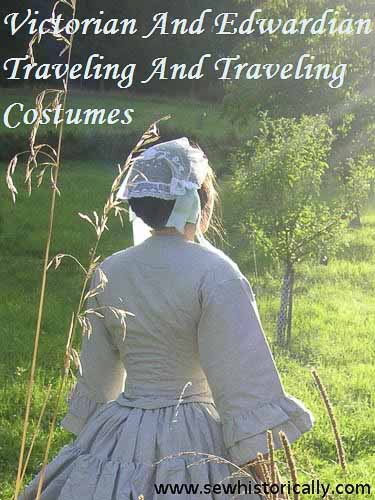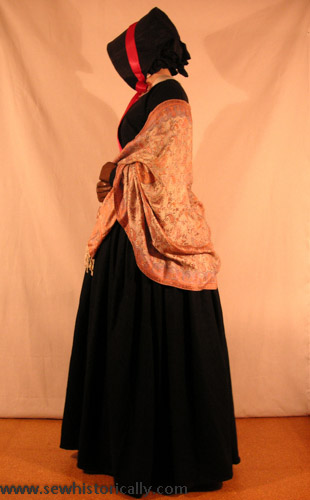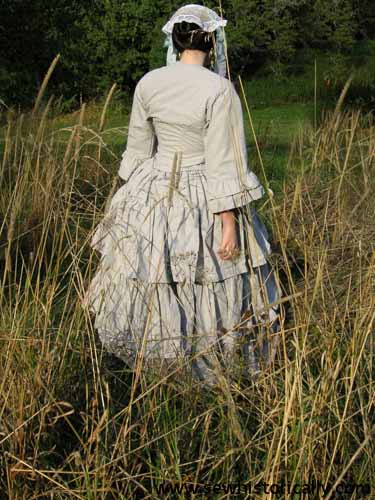Traveling costumes were simple, warm and practical in the Victorian and Edwardian era. Beige colors were worn for travels by coach, while dark dresses were worn on sea voyages.
About Victorian and Edwardian Traveling Costumes
1859 traveling dress: ‘Straw hat plainly trimmed with ribbon. Dress of the thinner species of poplin, or any desired material. If preferred, the sleeves may be flowing, being cut to match the design, with gauntlets. The skirt is single.’ Drawing of this traveling dress. Beige or natural-colored clothing was recommended for travels by coach to hide the dust of streets.
(1860s natural-colored linen dress)
A traveling dress in 1852 should be cut like a morning gown with a round waist (without the point in front). The skirt is made with strings underneath so that it may be looped up. The traveling costume also comprises: a corresponding collar and engageantes, a full wool mantle, dark suede gloves (iron grey, maroon, or olive is suitable), and brown, button up, thin leather boots with low heels. The bonnet is made of straw and taffeta with Cambrai lace veil for the face. An elastic traveling corset, the nonchalante, should be worn. (Harper’s New Monthly Magazine, 1852)
(1860s beige wool walking dress)
In 1909: a ‘Traveling costume should be simple in style and quiet in color, materials that will not show dirt being preferable. A waterproof cloak is a very desirable addition, as it may be at any time suddenly needed. In summer travel a long linen duster, belted at the waist, should be worn over the dress. For the country or sea-side, simple and inexpensive dresses should be provided for ordinary wear.’ (Household Companion: Book Of Etiquette, 1909)
(Victorian oiled silk raincoat)
Hints on Crossing the Sea in the 1850s (Miss Leslie’s New Receipts For Cooking, 1852)
‘The most usual voyage made by American ladies is across the Atlantic; and the time chosen for that voyage is generally in the spring or autumn’. A winter passage is usually avoided by ladies. If a lady can afford it, she should pay the additional costs for a whole room for herself so that she has additional space and privacy: ‘No one who has not been at sea can imagine the perpetual and mutual annoyance, of being confined to the small limits of a state-room with a stranger; each incommoding the other all the time, and each feeling herself under the continual surveillance of her companion; both expected to make incessant sacrifices to the convenience of each other, and perhaps only one of them having a disposition to submit to these sacrifices; in which case she that is the most amiable is always the sufferer.’
Pack away all light-colored and white dresses; wear dark dresses which need no washing: ‘As ladies can have no washing done at sea, it will be well to begin with such dresses as can be worn all the passage. French silks are not good sea dresses, (even when black,) for the salt-air shrivels, spots, and turns them rusty. Dark-coloured india silks, or dark mousse-lines de laine, or merinoes, are much better. Dark chintzes, with no white in the figure, are convenient for common wear, at sea as well as on shore.’ Also don’t wear quilled or pleated frills on your muslin or bobbinet collar because they lose the starch in the damp see air. You may substitute your collars with silk neckerchiefs or shawls, white is best. ‘Or you may wear a broad, thick white ribbon, shaped with three diminishing pleats, to fit in closely the back of the neck, and crossed in front.’ Wear simple day caps, lined with silk, with or without a gathered border, and satin ribbons instead of gauze ones. On rough days, it is ‘impossible to arrange the hair nicely’, so the hair should be covered completely.
Take enough warm clothing with you: ‘It is colder at sea than on shore; and even in summer, the atmosphere of the Atlantic is liable to be chilled for several days by the vicinity of floating icebergs, – even when these icebergs are not seen.’ Sometimes, the clothing is the only source of heat to be had. Especially on windy weather and when the sea is rough, a fire can’t be lighted in the cabin. Therefore, flannel underwear, a large woolen shawl, warm gloves, and a wadded coat of India silk, which won’t stain, are important. Your dresses should all fasten in front because a lady has most often to dress herself, and wrappers are now made ‘universially becoming’. Don’t change your clothing during the day, as ‘dressing on ship-board is always more or less troublesome and inconvenient’. Instead of a corset, wear a flannel, lined silk, or jeans bodice without whalebone stiffening. Wear a dark linen, silk, or worsted petticoat, or a wadded silk petticoat. Also pack ‘a pair of slightly-wadded silk inside-sleeves, to be tied in beneath your gown-sleeves in chilly weather. For this purpose, have four tapes sewed to the top of each sleeve, at equal distances, and four corresponding tapes sewed to the inside of each arm-hole of your gowns.’ Stockings should be of unbleached or dark cotton, shoes should be easy to put on – without lacing or button closure – with thin soles, such as moccasins. Better than the usual cork insole are sheep-skin soles ‘coated on the under side with india-rubber varnish’. The bonnet should have a ‘deep, close front’ to screen the complexion from sunrays, and be made with ‘wired-satin piping-cord’ instead of cane or whalebone which is ‘apt to break’ in strong winds.
‘However pleasant you may find it to stay on deck, it is best, as soon as you get on board, to go to your stateroom, and make your arrangements there, lest you should be rendered incapable of doing so by the approach of seasickness’. Take as a preventative or early remedy for seasickness some sugar with brandy. ‘For the first two days you need take no nourishment but chicken-water. Avoid lemonade, oranges, all other acids, and every sort of warm drink. Be careful, while you are sick, not to taste any thing that you may like to eat afterwards, as it will give you a disgust to it during the remainder of the voyage.’ Also don’t use perfume, such as eau de cologne, but you may sprinkle some camphor over your bed. ‘The third day (if not before) you ought to make every possible exertion to go on deck, as you will be losing strength by remaining in bed; and as long as you keep your head in a recumbent posture, you will not become accustomed to the motion of the vessel. Also, on the third day, endeavour to eat a small portion of solid, relishing food’.
Other useful travel accessories are ‘a clay-ball for the removal of grease spots […] as, when the ship is rolling, greasy substances are frequently spilt on dresses; and a life vest ‘ in case of being wrecked in sight of land’. It’s also beneficial to learn to swim before the sea voyage. Because a sea journey can be long and monotonous take plenty of interesting occupation with you: needle work, an amusing book, a journal, or write a ‘diary-letter’ to your family or friends.
Tropical Sea Voyage (San Francisco Call, 1905)
‘Sailor suits are almost always pretty and becoming, and just the thing to wear on an ocean steamer running through the tropics.’ A sailor suit ‘is of duck and so made as to draw over the head like a sweater, and it can be worn either with or without the little vest. The skirt is quite short, which is not only proper but necessary on board a steamer.
The sailor hat worn with this suit is very pretty, and serves a good purpose as a sunshade, but when the ocean breezes blow, then this hat must be securely “lashed” to some part of the wearer’s “rigging.” Caps are much preferable to hats on board a steamer, and much more comfortable, but they seem to have gone out of fashion entirely.
Even this sailor suit of duck will be found to be too warm as the steamer gets into the tropical zone, and is about to “cross the line.” Some thinner material must be substituted for it – something that is more gauzy, that the air can penetrate, and for this purpose organdie is perhaps as cool as anything, and certainly as pretty. Some very pretty women can be seen on a Tahitian steamer, prettily and becomingly dressed in organdies, dimities or mulls, which makes the deck look very gay and attractive. This is a very different appearance from a bleak Atlantic liner, whose passengers are bundled up in coats and steamer rugs, and sit round on deck looking cold and cheerless. […] a very pretty organdie dress, made with a great deal of lace and insertion. […]
Underclothes have to be considered, and they must be of the thinnest possible material. Flannel is hardly to be thought of, but the lightweight linen mesh may prove to be a good substitute for it, with a fine light chemise over it.
A very nice material for a gown in the tropics is net. It is cooler than organdie, even, and is more dressy. […] a very pretty white net gown […] lined with silk of the softest variety and prettily made with insertion and shirrings. […] Of course, these net gowns are hardly appropriate for steamer wear, but they are just the thing after the steamer reaches Tahiti, and the passengers are on shore. […] one’s dress must be very light and cool and simple, still it may be pretty and becoming.
Gloves are, of course, out of the question, but light mitts can be worn to prevent the hands from being browned “to a turn.” In Paris, mitts have been all the style this year […] The handsomest of them are netted by hand of fine twist, and there are both black and white real duchess and point lace mitts, and there are also openwork silk mitts in colors to match any gown.
A particularly necessary adjunct in the tropics is a parasol, more especially now that hats are being reduced to such small proportions […] There is the smart coaching parasol with the club handle, or the dainty lingerie parasol, that goes so well and looks so attractive with the lingerie hat. […] those that have the coolest appearance, are made of white taffeta. White is said to be the best color for absorbing the heat rays of the sun. The helmet hats of Indian and African English travelers are always white, though some of them are adorned with a loose green band around the base. A parasol of pale mignonette green moire, trimmed with frills of narrow lace on the border and on top […] one made of white taffeta, with a hand painted trailing design of water lilies, and their long green stems. […]
A dress that can be worn both on the steamer and on shore at the island is a white pique, linen or duck skirt, with a shirtwaist of cool lawn, especially when a lingerie hat and parasol are added. It is a costume dressy enough for afternoon tea. […]
The lingerie hat is the best to wear in the tropics. It is light and cool, and looks cool’. One ‘made of blue chiffon and ecru lace’ or an ’embroidered linen one’.
About Carpet Bags and Packing (The Workwoman’s Guide, 1840)
‘Carpet bags should be purchased with large gores at the sides, as when thus made, they contain many more articles, and more conveniently than when they are only two plain pieces of carpet. They should also have a brass plate. […] every bag should have two locks […]
Here are instructions for making a travel bag.
When the party sleep several nights on the road, it is advisable to have a large carpet bag containing the night-dress of each individual packed up in night-gown bags, dressing tidies (see Plate 24), marked with the initials of the persons; by this means much trouble is saved. It is a good plan to sew a camphor bag in the night-gown to prevent the attack of fleas and bugs.
Here are instructions for making a nightgown bag for travelling.
In packing observe the following general rules: –
First, divide the light things from the heavy ones; lay drawings, portfolios, books, desks, boxes, shoes, and all hard flat things at the bottom of your trunk, taking great care to fit them together, so as to be perfectly even at the top, putting paper, or any small soft things in the crevices; then put in a packing cloth, and on this lay flannels, linen, &c., &c.: these things should be opened to their full extent and laid quite flat; in the corners, stockings, rolls of ribbon, &c. may be put; silk or any thick dresses, folded […] may be laid at the top, and the whole carefully covered with the packing sheet tightly pinned down, and strong brown paper to prevent the possibility of rain getting in.
Bonnets, caps, muslin, or gauze dresses, and collars, should be put in a box by themselves: tapes may be nailed across the box and the bonnets or caps pinned to them to keep them steady.
In packing a carpet bag, it is well to roll every thing possible in small compact parcels, and to put them in, very close together, especially at the corners and ends, keeping the bag as flat as it can be, and stretched out to its full extent, width-wise at the same time.’



